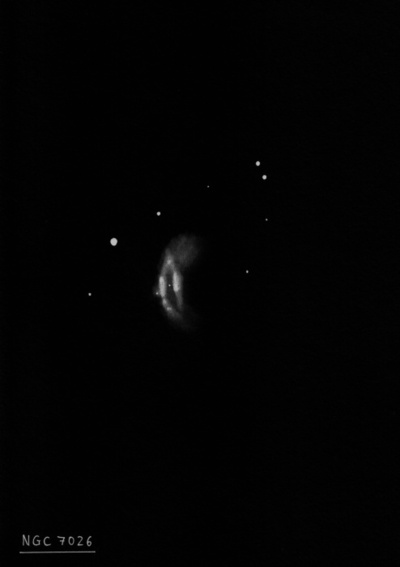
Sherburne Burnham discovered NGC 7026 on 6 Jul 1873 with his personal 6-inch Clark refractor at his home in Chicago (Memoirs of the RAS, Vol 44, p295). It was described in his "Third Catalogue of Double Stars (1873) as "a very remarkable and curious double, or elongated planetary (?) nebula. It is close to a 9.3m star. This may have been noted before, but it is not in Herschel's General Catalogue, or Lassell's Catalogue of New Nebulae." It was also included in his 1879 "Double Star Observations made in 1877-8 at Chicago with the 18 1/2-inch Refractor of the Dearborn Observatory, comprising: I. A Catalogue of 251 New Double Stars with Measures; II. Micrometrical Measures of 500 Double Stars." He noted the "distance between nuclei as 2.57". Dreyer missed Burnham's two discovery notes, so NGC 7026 wasn't added to the General Catalog Supplement.
Ralph Copeland independently found this planetary on 18 Nov 1880 using a visual spectroscopic sweep and announced "a new planetary nebula has been found by Dr. Copeland at Dunecht, using Prof. Pickering's method of search." Burnham caught Copeland's "discovery" note and claimed priority in another 1881 article ("The planetary nebula in Cygnus"). Burnham later studied NGC 7026 with the 36" Lick refractor.
In 1909, Rev. Thomas Espin wrote (1909MNRAS..70..184E), "This autumn I have observed the nebula on several occasions. It consists of two elongated masses running N and small, each of which has a nucleus. To my eye the preceding nucleus is slightly brighter, and I have estimated them as 11.2, 11.4 mag, respectively. On Nov. 15 it seemed to me that the south part of the nebula ends more abruptly than the north. On the same night a faint star was suspected at the south end, and attempts were made to measure it. On all occasions the space between the two masses has seemed filled with nebulosity, and the object has appeared as one nebula with two nuclei."
Based on Crossley photographs taken at Lick, Heber Curtis (1918) reported "very irregular; there are two bright lobes 5" long in the shorter exposures symmetrically placed with regard to the central star, and about 6" apart from center to center. A bright of nebulosity connects these and involves the central star, so that it resembles the letter H. Irregular wisps extend from each end of this formation, making the total length about 25" in p.a. about 10°.
Jay McNeil coined the nickname "Cheeseburger Nebula" in 1994 with a 10" f/5 Cave reflector. "It very much so reminded me of a small, nebulous hamburger with two perfectly shaped "buns" separated by a long thin dark lane (the meat ;-)."
300/350mm - 13" (9/3/83): at 333x appears fairly bright, very small, elongated WSW-ENE. Two brighter condensations at the opposite ends are possibly barely detached at the center. Forms a double at low power with a comparable mag 11 star 27" NE of center.
400/500mm - 17.5" (7/9/99): fascinating object at 380x both with and without a UHC filter. The double-lobed structure is clearly visible with the western lobe slightly elongated N-S and containing a brighter center. The eastern knot also has a quasi-stellar center at moments using direct vision and the knot has an irregular outline. Using the UHC, the lobes are more cleanly separated and the small fainter halo that encases the two bright lobes is more obvious. A mag 11 star is just 0.5' NE of center. Located 12.5' NNW of mag 4.7 63 Cygni.
Notes by Steve Gottlieb